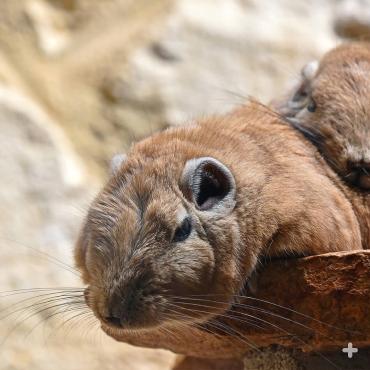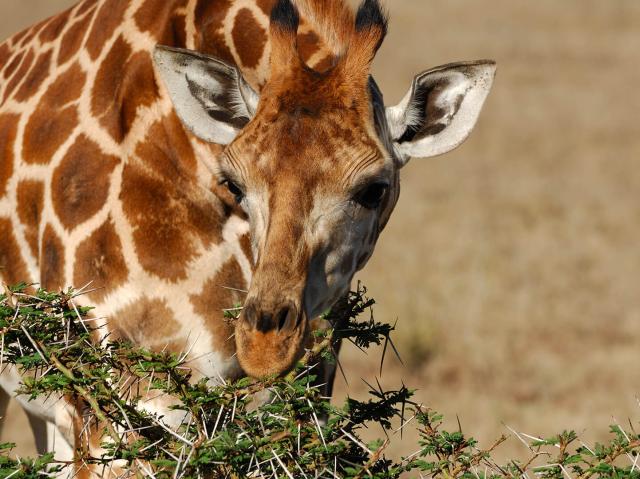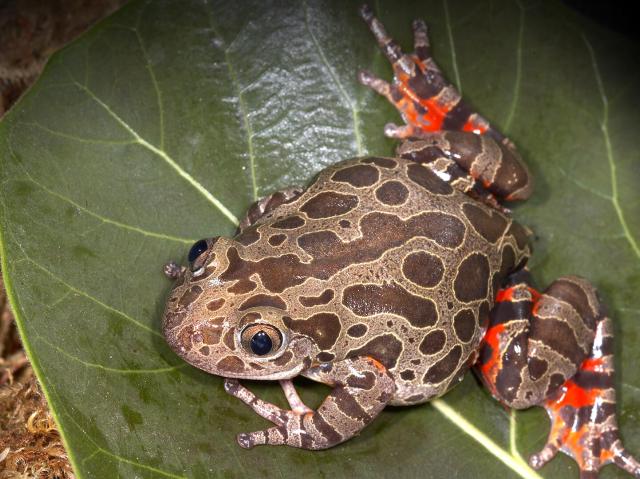
Gundi

- CLASS: Mammalia
- ORDER: Rodentia
- FAMILY: Ctenodactylidae
- GENERA: Ctenodactylus, Felovia, Massautiera, Pectinator
- SPECIES: C. gundi, C. vali, F. vae, M. mzabi, P. spekei

ABOUT
Little but mighty. Short and stout, gundis might be the most interesting rodent you've never heard about! Looking a bit like puffy potatoes, gundis are relatively recent news to the western zoological world, as John Speke wrote about them in the mid-19th century during an expedition in the coastal hills of Somalia. They also have a lot to say for such small rodents—each species has its own song book of vocalizations.
Roly-poly rodents. There are five species of gundis—North African, desert, Mzab, Felou, and Speke's—and they share certain characteristics. Topping out at a little over 7 ounces (almost 200 grams), gundis move fast on short legs. Their large, blunt heads are dominated by big eyes and long whiskers. Their ears are large, and in some, protected by fringe around the inner edge. The Mzab gundi's ears are flattened against its head and do not move. Females are slightly larger than males.
Their bodies may be a little guinea pig-like, but that's where the similarities end, as there is a tale about their tails: The North African and desert gundis have short wispy tails, but the other three varieties have fan-like tails that they use for balance. The Speke's gundi even uses its elaborate tail fan in social displays.
Don't forget to comb your fur! There is something interesting afoot with gundis—they have only four toes on each foot and the middle toes of their hind feet sport white, comb-like bristles (hence its other common name, "comb rat"). The family name, Ctenodactylidae, even means "comb-fingered." They use the combs for scratching. Their ultra-sharp claws—necessary for rock-climbing—would tear into their soft, silky, dense fur. And they need that fur to stay insulated against extreme cold or heat. Gundi coat colors range from grayish or buff to chestnut or yellowish red, with paler underparts. The color of each type of gundi matches the rocks in which it lives.
HABITAT AND DIET
On the rocks. Gundis make their homes in all types of rocky desert places, cliffs, hills, and rocky outcroppings in Northern Africa, from Mauritania and Morocco, east to Entrea and Somalia. Populations can be found between sea level and over 8,200 feet (2,500 meters) in elevation.
Listening for trouble. Snakes, lizards, foxes, jackals, cats, and hawks all consider the gundi a nice meal. Luckily, the gundi has a few escape tricks up its sleeve. Their acute hearing that results from their ear structure is important for picking up weak low-frequency sounds of those predators sliding, sneaking, or flapping as they stalk the gundi. Another tactic? Playing possum. If threatened, the gundi enters an immobile, trance-like state. This confuses sight-centric hunters, The gundi lies flat and completely still, and may even stop breathing for up to a minute.
I'll have the veggie plate. Gundis are herbivores. They eat stalks, leaves, flowers, and seeds of almost any desert plant, including grasses and acacia trees. Gundis are not great gnawers and their incisors don't have the hard orange enamel found in most rodents' mouths. They don't usually drink water because they get their moisture from plants. Their kidneys have long tubules for absorbing water and, under extreme conditions, their urine can be concentrated, although this can only be sustained for a short time.
FAMILY LIFE
Rock on—and in. Gundis do not make nests or dig burrows. They live in natural crevices and caves in rocky places. Rocks must not be too large, and fissures, crevices, and caves are necessary for permanent and temporary shelters. The ledges, flat rocks, and boulder tops make nice gundi sunbathing spots. They often seek out places that are easterly facing so that they are exposed to the morning sun, and ideally some of the evening sun.
Day workers. Unlike most small rodents, gundis are active during the day. They normally come out of their caves and crevices at dawn and remain active for up to five hours. Activity declines during the hottest part of the day, and then increases again in the two to four hours until dark. Gundis live in colonies ranging from the tiny (maybe three member) groups of Mzab; to hundreds of Speke's gundis. Within a colony, there are family territories that are home to a pair and their juveniles; or several females and their offspring. Survival is a group effort—if it gets cold, gundis pile on top of each other in their caves for warmth. Those noteworthy feet also play a role beyond holding the gundis' combs—the soles have rough friction pads that are so helpful with climbing that they can ascend almost vertical surfaces, keeping the body pressed close to the rock face.
What's that you say? Each gundi species speaks its own "language." The Mzab gundi chirps infrequently, while the the Speke's gundi emits complex chirps, chuckles, and whistles. The Felou gundi uses harsh "chee-chee" sounds to get its point across. The other two—North African and desert—differ the most, with the North African chirping and the desert species whistling. Because their ranges overlap, this is helpful, as the "members" can recognize their own kind. There is one "warning system" that all gundis share: they thump with their hind legs when alarmed.
They grow up so fast! Most gundis have babies between January to March, and again in June; female Speke's gundis in anestrus only in July. After about 55 days gestation, females give birth to 1 to 3 fully furred, open-eyed babies. The little ones are brought out into the open within a few hours of birth. They are left in a rock shelter while the mother forages for food, with their constant chirping helping to guide her back to them. The babies don't nurse much, and are fed chewed leaves from the start. Weaning is complete at about four months of age.
CONSERVATION
Habitat fragmentation has pushed the Felou gundi to a status of Vulnerable. Other gundis are not globally threatened, although some may face declining populations due to hunting for food, human encroachment, and predation by domestic cats and dogs.













